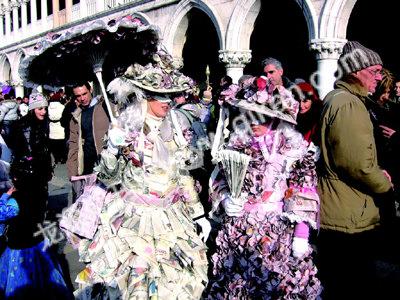My?。郑椋螅椋簟。簦铩。郑澹睿椋悖?/h1>
2009-06-30 09:39HuangBin
文化交流 2009年3期
Huang Bin

Long before I set my foot on Venice, I had heard of the charms of its history, architecture, culture and art.
Traveling by train from Florence, I arrived at Venice before midnight. Outside the railway station was a canal where gondolas and waterbuses came and went. The riot of neon lights from bars and cafés were everywhere, travelers meandered; the churches, courtyards and canals looked mysterious and serene. I did not allow myself to get lost in the maze of mysteries. I checked into a hotel near the railway station.
After a brief breakfast next morning, I wandered into the labyrinth of palaces, bridges, lanes where history lingered and water beauty stayed.
A city of water, it has 118 small isles crisscrossed by 150 canals and 400 bridges. The canals are like a giant spider web that connects all the parts of the city. Ancient houses and lanes between them gave me a glimpse into ancient charms as they came into my view and then vanished.
Venice is famed for its architecture, art and culture. There are more than 400 churches, monasteries, palaces, bell towers, museums and galleries, serving as tangible witnesses to the glory of the Renaissance. During the Renaissance, painting masterpieces by artists helped make Venices reputation spread far and wide.
Piazza San Marco (often known in English as Saint Marks Square) is the principal square of Venice and its center of politics, religion and traditional celebrations. The best and most famous buildings in the city cluster here. At the waterfront end of the Piazza is the Piazzetta where two 12th-century columns tower in commemoration of San Marco and San Teodoro.
Saint Marks Basilica, the cathedral of Venice, was first built in 832 and rebuilt in 1063 after it was destroyed by a fire in 976. It is one of the best known examples of Byzantine architecture. The domes and spires look wonderful.
Above the central door of the five round-arched portals is a magnificent gilded mosaic. The church is a wealth of art treasures. The clock tower stands 98.5 meters tall and is the highest point of Venice where tourists can take a commanding view of Venice.
Doges Palace is a gothic palace in one part of the square. During the republican years the palace housed political institutions. The Bridge of Sighs links the palace to the prison. Today visitors see some famous paintings there. More masterpieces can be seen in various museums across the city.
Bridges are a major attraction in Venice. Every bridge has a tale to tell. The most famous bridges are Rialto Bridge, The Bridge of Sighs, Accademia Bridge, Scalzi Bridge. Rialto Bridge, built in 1181, is the first pedestrian bridge across the Grand Canal. After several collapses, the timber structure was finally rebuilt in stone. Today, it spans 48 meters and is 7 meters above the water. In the center of the bridge is a central portico.
Venice is also famed for events and festivals. The most famous is the Carnival of Venice held in February every year. First recorded in 1268, the traditional celebration sees people dressed in outlandish costumes and masks. People participate in street parades, theater performances, gatherings, masquerades.
The oldest film festival and one of the most prestigious film festivals in the world, the annual Venice Film Festival in late August and early September attracts filmmakers and film artists from all over the world. It is held on the island of the Lido and it is part of the Venice Biennale, a major biennial exhibition and festival for contemporary art.
Regattas are held at regular intervals around the year.□
Huang Bin

Long before I set my foot on Venice, I had heard of the charms of its history, architecture, culture and art.
Traveling by train from Florence, I arrived at Venice before midnight. Outside the railway station was a canal where gondolas and waterbuses came and went. The riot of neon lights from bars and cafés were everywhere, travelers meandered; the churches, courtyards and canals looked mysterious and serene. I did not allow myself to get lost in the maze of mysteries. I checked into a hotel near the railway station.
After a brief breakfast next morning, I wandered into the labyrinth of palaces, bridges, lanes where history lingered and water beauty stayed.
A city of water, it has 118 small isles crisscrossed by 150 canals and 400 bridges. The canals are like a giant spider web that connects all the parts of the city. Ancient houses and lanes between them gave me a glimpse into ancient charms as they came into my view and then vanished.
Venice is famed for its architecture, art and culture. There are more than 400 churches, monasteries, palaces, bell towers, museums and galleries, serving as tangible witnesses to the glory of the Renaissance. During the Renaissance, painting masterpieces by artists helped make Venices reputation spread far and wide.
Piazza San Marco (often known in English as Saint Marks Square) is the principal square of Venice and its center of politics, religion and traditional celebrations. The best and most famous buildings in the city cluster here. At the waterfront end of the Piazza is the Piazzetta where two 12th-century columns tower in commemoration of San Marco and San Teodoro.
Saint Marks Basilica, the cathedral of Venice, was first built in 832 and rebuilt in 1063 after it was destroyed by a fire in 976. It is one of the best known examples of Byzantine architecture. The domes and spires look wonderful.
Above the central door of the five round-arched portals is a magnificent gilded mosaic. The church is a wealth of art treasures. The clock tower stands 98.5 meters tall and is the highest point of Venice where tourists can take a commanding view of Venice.
Doges Palace is a gothic palace in one part of the square. During the republican years the palace housed political institutions. The Bridge of Sighs links the palace to the prison. Today visitors see some famous paintings there. More masterpieces can be seen in various museums across the city.
Bridges are a major attraction in Venice. Every bridge has a tale to tell. The most famous bridges are Rialto Bridge, The Bridge of Sighs, Accademia Bridge, Scalzi Bridge. Rialto Bridge, built in 1181, is the first pedestrian bridge across the Grand Canal. After several collapses, the timber structure was finally rebuilt in stone. Today, it spans 48 meters and is 7 meters above the water. In the center of the bridge is a central portico.
Venice is also famed for events and festivals. The most famous is the Carnival of Venice held in February every year. First recorded in 1268, the traditional celebration sees people dressed in outlandish costumes and masks. People participate in street parades, theater performances, gatherings, masquerades.
The oldest film festival and one of the most prestigious film festivals in the world, the annual Venice Film Festival in late August and early September attracts filmmakers and film artists from all over the world. It is held on the island of the Lido and it is part of the Venice Biennale, a major biennial exhibition and festival for contemporary art.
Regattas are held at regular intervals around the year.□

